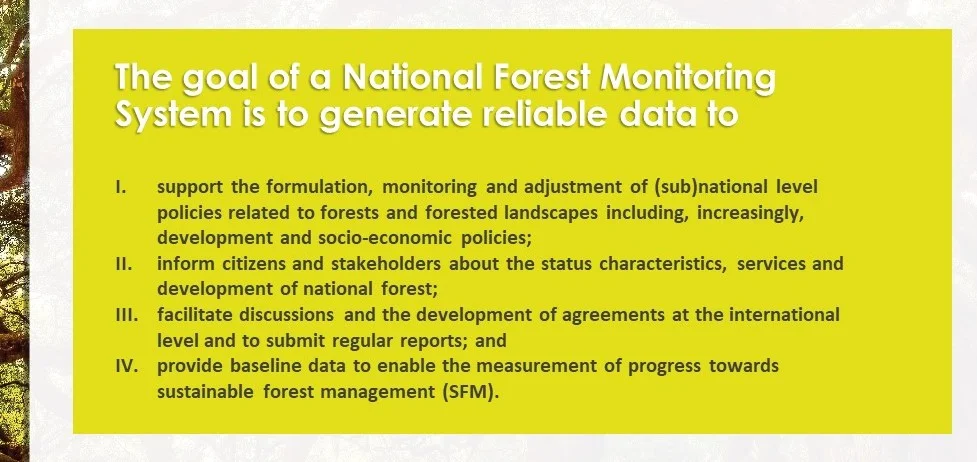How a Robust National Forest Monitoring System Can Boost Transparency under the Paris Agreement

Three years ago, the Paris Agreement came into effect and with it, a global commitment to limiting the increase of the global average temperature. To meet this goal, countries have put forward their Nationally Determined Contributions (NDCs), which form the basis for implementing actions under the Paris Agreement.
Forests have the potential to contribute approximately one quarter of total intended emission reductions. Recognizing this, many developing countries have embarked on a journey to reduce emissions from deforestation and forest degradation (REDD+). In order to support them in planning, implementing and monitoring these reductions, technical support to overcome data gaps and improve the quality and transparency of forest-related data and information is offered under various initiatives, including the UN-REDD Programme.
Forest monitoring is critical to ensuring that countries stay on target with emission reduction goals. Additionally, it enables countries to align their forest policies with up-to-date, reliable, transparent and accessible information. Over the last 10 years, capacity development supported by the UN-REDD Programme has led to unprecedented transparency in forest data, with a growing number of countries able to meet international reporting requirements. In addition, continued capacity development on the National Forest Monitoring System (NFMS), experience with Forest Reference Levels (FRL), REDD+ results reporting and the associated technical assessments and analysis have all provided useful lessons in drawing up the Paris Agreement’s enhanced transparency framework. Let’s take a look at this link more closely.
National Forest Monitoring (NFM)
NFM is a comprehensive process that includes systematic collection, analysis and dissemination of forest-related data, usually from repeated inventories (using both remote sensing and ground data) that allows for the monitoring of change and trends over time (FAO, 2017). Therefore, for countries to focus on data that will support forest-related decision-making at international, national and sub-national levels, a transparent, reliable and long-term NFMS is needed.

NFMS Support under the UN-REDD Programme
The UN-REDD Programme has supported 40 countries in developing NFMS since its inception. This has included technical support for Satellite Land Monitoring Systems (SLMS), used for generating land-cover and land-use change information. In addition, 25 countries have received support for developing national web portals for their NFMS, with 15 countries having launched operational platforms disseminating NFMS information. Since the UN-REDD Programme began, 18 countries have received support and made progress on their National Forest Inventories (NFIs).
Over the last 10 years, the UN-REDD Programme has helped 29 countries meet their international reporting requirements and generate data to improve the quality of reporting and enhance transparency. It has supported open-source modular solutions for satellite and ground data processing through Open Foris with over 20,000 country installations.
Enhanced Transparency Framework
The Enhanced Transparency Framework (ETF) is a key element of the Paris Agreement; it builds on the existing transparency arrangements under the United Nations Convention on Climate Change (UNFCCC), namely the Measurement, Reporting and Verification (MRV) framework. Many countries are now actively engaged in establishing the necessary activities to implement the ETF, guided by the modalities, procedures and guidelines for transparency. So how can NFMS results and knowledge support countries in their efforts to contribute to the ETF?
Under the ETF, robust data collection is at the basis for reporting on emissions and removals and tracking NDC progress. Given the significant mitigation potential of forests, it is timely, and in fact urgent, that we improve the transparency of forest-related data and information within the ETF to translate this potential into action.

Sustainable NFMS for Continuous Transparency
Ideally, NFMS can be a long-term endeavor. Therefore, a legal basis, financial commitment and a permanent institutional framework are vital to ensuring efficient implementation and operation. Among the most important elements to sustaining the NFMS are:
-
integration of the NFMS into existing national frameworks, including policies and legislation and into government structures and financing systems;
-
provision of sustainable (international and national) funding for the NFMS;
-
formal assignment through legal instruments of clear mandates (roles and responsibilities) to an organization or network of organizations such as government agencies, research organizations or academic institutions, for the collection, management and analysis of data and for the delivery of specific products/services;
-
coordination mechanisms for overall data management and sharing.
A fully functioning NFMS will allow countries to not only effectively report their NDCs under the Paris Agreement, but will also enable them to respond to their own multi-purpose national data needs on trees and forests. The recently approved, FAO-GEF global project, “Building global capacity to increase transparency in the forest sector (CBIT-Forest),” will empower developing countries to achieve these goals, and at the same time, build the trust and transparency so crucial for tackling climate change and shaping the global course of action toward a sustainable world.
Related article:
Moving towards the transparency framework under the Paris Agreement
Useful links:
FAO’s work on climate change 2018 (also in Spanish, French)
FAO’s infographic booklet on MRV work (also in Spanish, French)
Mapping Katowice decisions related to NDCs (also in Spanish)
FAO’s technical paper on REDD+ 2017, with update 2018, update 2019
FAO’s Voluntary Guidelines on National Forest Monitoring 2017 (also in Spanish, French)
FAO’s National Forest Monitoring Systems for REDD+ (also in Spanish)
Authors:

Rocío D. Cóndor-Golec
MRV/ETF expert
REDD+/NFM cluster
Forestry Department, FAO

Rebecca Tavani
NFI expert
REDD+/NFM cluster
Forestry Department, FAO
